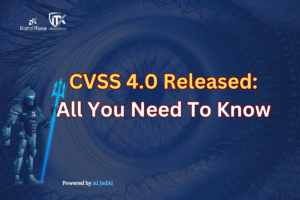
Lalit Ahluwalia is committed to redefining the future of cybersecurity by helping large, medium, and small-scale businesses build digital trust. Here, Lalit introduces the recent CVSS 4.0 published by FIRST, key changes to note, benefits & considerations, and outcome-based strategies to implement CVSS 4.0 in your organization. If you’re looking to find everything you need to know about this recent CVSS update, this article will help you.

Staying ahead of vulnerabilities and assessing their severity is of paramount importance in the ever-evolving landscape of cybersecurity. This is where the Common Vulnerability Scoring System (CVSS) comes into play. CVSS provides a standardized approach to evaluate the impact and exploitability of vulnerabilities.
With the recent release of CVSS 4.0, it’s time to dive into the details and explore the enhancements and benefits it brings to the table.
The Need for CVSS 4.0
CVSS 4.0 addresses the need for a more comprehensive and accurate vulnerability scoring system. As organizations face increasingly complex threats, the ability to prioritize vulnerabilities based on their potential impact becomes crucial. CVSS 4.0 takes a step further by considering not only the severity of the vulnerability but also the environmental factors that can influence the risk.
This ensures that organizations can tailor their risk assessment according to their specific security requirements and better allocate resources to mitigate the most critical vulnerabilities.
Embracing Environment-Specific Security Requirements
One of the key enhancements in CVSS 4.0 is its acknowledgment of the diverse security postures of organizations. It recognizes that what might be a critical vulnerability in one environment may not hold the same weight in another. By embracing environment-specific security requirements, CVSS 4.0 aims to provide a more tailored and realistic assessment of the risks organizations face.
Key Enhancements in CVSS 4.0
CVSS 4.0 introduces several key enhancements that improve the accuracy and granularity of vulnerability scoring.
- Scope: In CVSS 4.0, the concept of “Scope” is introduced to differentiate between vulnerabilities that affect only the vulnerable component and those that can impact other components within the system. This helps in evaluating the potential reach of an exploit and enables organizations to prioritize accordingly.
- Attack Vector: The Attack Vector metric in CVSS 4.0 has been expanded to include additional categories such as adjacent network, local, physical, and wireless. This provides a more nuanced understanding of the different ways an attacker can exploit a vulnerability, allowing organizations to assess the risks more accurately.
- Privileges Required: CVSS 4.0 introduces a more refined Privileges Required metric, taking into account whether the vulnerability requires no privileges, low privileges, or high privileges to be exploited. This enables organizations to evaluate the potential impact based on the attacker’s level of access.
- User Interaction: The User Interaction metric in CVSS 4.0 now includes three distinct categories: none, required, and optional. This accounts for vulnerabilities that can be exploited without any user interaction, those that require user interaction, and those where user interaction is optional. This provides a more nuanced understanding of the attack vectors and helps organizations assess the risks accurately.
- Impact Metrics: CVSS 4.0 introduces a refined set of impact metrics, including confidentiality, integrity, and availability. Each metric is now evaluated on a separate scale, allowing organizations to assess the impact on each aspect independently and make informed decisions based on their specific security requirements.
Benefits and Considerations
CVSS 4.0 brings significant benefits to organizations looking to prioritize vulnerabilities effectively and allocate resources efficiently. By considering environmental factors, such as the presence of mitigations or the impact on specific systems, organizations can tailor their risk assessments to their unique contexts. This enables them to focus on the vulnerabilities that pose the most significant risks and mitigate them accordingly.
However, it is important to note that the mileage organizations will get from CVSS 4.0 may vary. The effectiveness of CVSS 4.0 relies on accurate input data, such as the configuration and context of the affected systems. Organizations must invest time and effort in collecting and maintaining accurate data to ensure the reliability of the vulnerability scoring.
Additionally, CVSS 4.0 is a tool that aids in vulnerability prioritization and risk assessment. It should not be the sole determinant of an organization’s security strategy. Other factors, such as the organization’s risk appetite, business context, and threat landscape, should also be considered to make informed decisions.
Strategies for Effectively Implementing CVSS 4.0
1. Comprehensive Training:
Ensure that your cybersecurity team is well-versed in the nuances of CVSS 4.0. Provide comprehensive training to enhance their understanding of the updated metrics and scoring methodology.
2. Integration with Security Processes:
Seamlessly integrate CVSS 4.0 into your existing security processes. Align vulnerability assessment and remediation efforts with the updated scoring system to enhance overall efficacy.
3. Regular Updates and Calibration:
The threat landscape is dynamic, and vulnerabilities evolve. Regularly update your CVSS 4.0 scoring and calibration processes to reflect the changing nature of cyber threats.
4. Collaboration and Knowledge Sharing:
Foster collaboration and knowledge sharing within the cybersecurity community. Exchange insights and best practices for leveraging CVSS 4.0 effectively to enhance collective cybersecurity resilience.
5. Customization Based on Organizational Needs:
Leverage the customization capabilities of CVSS 4.0 to align with your organization’s specific security requirements. Tailor the scoring system to prioritize vulnerabilities based on your unique risk landscape.
Conclusion
CVSS 4.0 is a significant step forward in vulnerability scoring and prioritization. By considering environmental factors and introducing enhanced metrics, it provides organizations with a more accurate and granular understanding of vulnerabilities and their potential impact. However, it is essential to remember that CVSS 4.0 is one piece of the puzzle. Organizations must combine it with other risk management practices and consider their unique context to develop a robust and effective cybersecurity strategy.
As the threat landscape continues to evolve, CVSS 4.0 empowers organizations to stay one step ahead by enabling them to prioritize vulnerabilities and allocate resources effectively. By embracing this enhanced scoring system and integrating it into their risk management frameworks, organizations can strengthen their security posture and mitigate potential risks more efficiently.
See: CVSS v4.0 User Guide by FIRST
Related Articles
‘Quishing’: Addressing the Rise of QR Code-Enabled Phishing Threats
A 5-Step Guide to Integrate Digital Trust in Your Business Strategy



